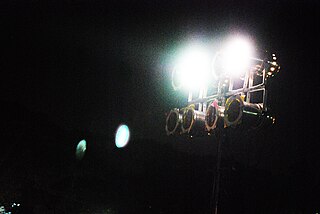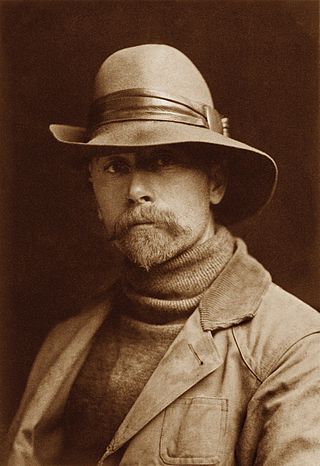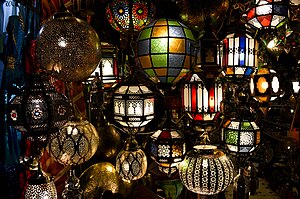The film industry is built upon many technologies and techniques, drawing upon photography, stagecraft, music, and many other disciplines. Following is an index of specific terminology applicable thereto.

Stage lighting is the craft of lighting as it applies to the production of theater, dance, opera, and other performance arts. Several different types of stage lighting instruments are used in this discipline. In addition to basic lighting, modern stage lighting can also include special effects, such as lasers and fog machines. People who work on stage lighting are commonly referred to as lighting technicians or lighting designers.

A Fresnel lens is a type of composite compact lens which reduces the amount of material required compared to a conventional lens by dividing the lens into a set of concentric annular sections.

A flashlight (US), or torch (CE) is a portable hand-held electric lamp. Formerly, the light source typically was a miniature incandescent light bulb, but these have been displaced by light-emitting diodes (LEDs) since the early 2000s. A typical flashlight consists of the light source mounted in a reflector, a transparent cover to protect the light source and reflector, a battery, and a switch, all enclosed in a case.

A headlamp is a lamp attached to the front of a vehicle to illuminate the road ahead. Headlamps are also often called headlights, but in the most precise usage, headlamp is the term for the device itself and headlight is the term for the beam of light produced and distributed by the device.

A Klieg light is an intense carbon arc lamp especially used in filmmaking. It is named after inventor John Kliegl and his brother Anton Kliegl. Klieg lights usually have a Fresnel lens with a spherical reflector or an ellipsoidal reflector with a lens train containing two plano-convex lenses or a single step lens.

A gobo is an object placed inside or in front of a light source to control the shape of the emitted light and its shadow.

In stage lighting, an ellipsoidal reflector floodlight, better known as a scoop, is a large, simple lighting fixture with a dome-like reflector, large high-wattage lamp and no lens. It consists almost entirely of a lamp in the center of a big curved metal dome that acts as a reflector. The result is a wide, soft-edged pool of light good for general lighting. However, since scoop lights do not have a mechanism for cutting down the size of their beam, they are rarely used for more specific lighting needs.

A parabolic aluminized reflector lamp is a type of electric lamp that is widely used in commercial, residential, and transportation illumination. It produces a highly directional beam. Usage includes theatrical lighting, locomotive headlamps, aircraft landing lights, and residential and commercial recessed lights.

Intelligent lighting refers to lighting that has automated or mechanical abilities beyond those of traditional, stationary illumination. Although the most advanced intelligent lights can produce extraordinarily complex effects, the intelligence lies with the human lighting designer, control system programmer(For example, Chamsys and Avolites), or the lighting operator, rather than the fixture itself. For this reason, intelligent lighting (ILS) is also known as automated lighting, moving lights, moving heads, or simply movers.

A Fresnel lantern is a common lantern used in theatre that employs a Fresnel lens to wash light over an area of the stage. The lens produces a wider, soft-edged beam than a spotlight or key light, and is commonly used for back light and top light.

Stage lighting instruments are used in stage lighting to illuminate theatrical productions, concerts, and other performances taking place in live performance venues. They are also used to light television studios and sound stages.

Portrait photography, or portraiture, is a type of photography aimed toward capturing the personality of a person or group of people by using effective lighting, backdrops, and poses. A portrait photograph may be artistic or clinical. Frequently, portraits are commissioned for special occasions, such as weddings, school events, or commercial purposes. Portraits can serve many purposes, ranging from usage on a personal web site to display in the lobby of a business.
A beam projector is a lenseless stage lighting instrument with very little beam spread. It uses two reflectors. The primary reflector is a parabolic reflector and the secondary reflector is a spherical reflector. The parabolic reflector organizes the light into nearly parallel beams, and the spherical reflector is placed in front of the lamp to reflect light from the lamp back to the parabolic reflector, which reduces spill. The result is an intense shaft of light that cannot be easily controlled or modified. Beam projectors are often used to create a godspot effect. The beam projector no longer is used to the extent that it once was, as newer fixtures and PAR lamps have created easier ways to produce the effect. A similar effect can be produced using ETC Source Four PAR fixtures with a clear lens. A snoot/top hat can be added to control spill.

The SeaChanger Color Engine is an electro-mechanical device that is used to control light color in entertainment-industry lighting applications. The unit employs four overlapped color filter wheels, inserted into a light beam near its source, to produce colored light. This is in contrast to color scrollers, which insert color filter ribbons into a light beam. The color engine, which was released by Ocean Thin Films in 2005, is designed to fit into the Source Four lighting instrument made by Electronic Theatre Controls.

LED stage lighting instruments are stage lighting instruments that use light-emitting diodes (LEDs) as a light source. LED instruments are an alternative to traditional stage lighting instruments which use halogen lamp or high-intensity discharge lamps. Like other LED instruments, they have high light output with lower power consumption.

Vari-Lite is a brand of automated, variable-colour stage lighting systems. Their intelligent lighting fixtures are commonly used in theatre, concerts, television, film and corporate events.
The design of photographic lenses for use in still or cine cameras is intended to produce a lens that yields the most acceptable rendition of the subject being photographed within a range of constraints that include cost, weight and materials. For many other optical devices such as telescopes, microscopes and theodolites where the visual image is observed but often not recorded the design can often be significantly simpler than is the case in a camera where every image is captured on film or image sensor and can be subject to detailed scrutiny at a later stage. Photographic lenses also include those used in enlargers and projectors.
Articles related to the field of motion pictures include:
Stage lighting accessories are components manufactured for conventional (non-automated) stage lighting instruments. Most conventional fixtures are designed to accept a number of different accessories designed to assist in the modification of the output. These accessories are intended to either provide relatively common functionality not originally provided in a fixture, or to extend the versatility of a lighting instrument by introducing features. Other accessories have been designed to overcome limitations or difficulties some fixtures present in specific applications.
























